| dc.description.abstract | The task of achieving suitable wastewater disinfection without formation of dangerous disinfection
by products by chemical disinfectants, as well as increasing need for a versatile wastewater
disinfection and reuse systems demands for a new technologies for efficient disinfection and
microbial control mechanism. Titanium dioxide (TIO2) a metal oxide semiconductor nanomaterial
has proved as a powerful antibacterial, antiviral and antifungal properties through diverse
mechanism of photo catalytic production of reactive hydroxyl and oxygen species on their surfaces
in the presence of solar photons hvwhich inhibits enzyme activity and DNA synthesis ,damages the
bacterial cell components and viruses in wastewater that contains these pathogenic agents. This
paper reviews the antimicrobial mechanism and disinfection efficiency of Titanium dioxide (TIO20
nanoparticle, discusses their merits, limitations and applicability for wastewater disinfection, and
highlights research needs by involving more people in order to exploit innovative TIO2
nanomaterial in wastewater disinfection | en_US |

